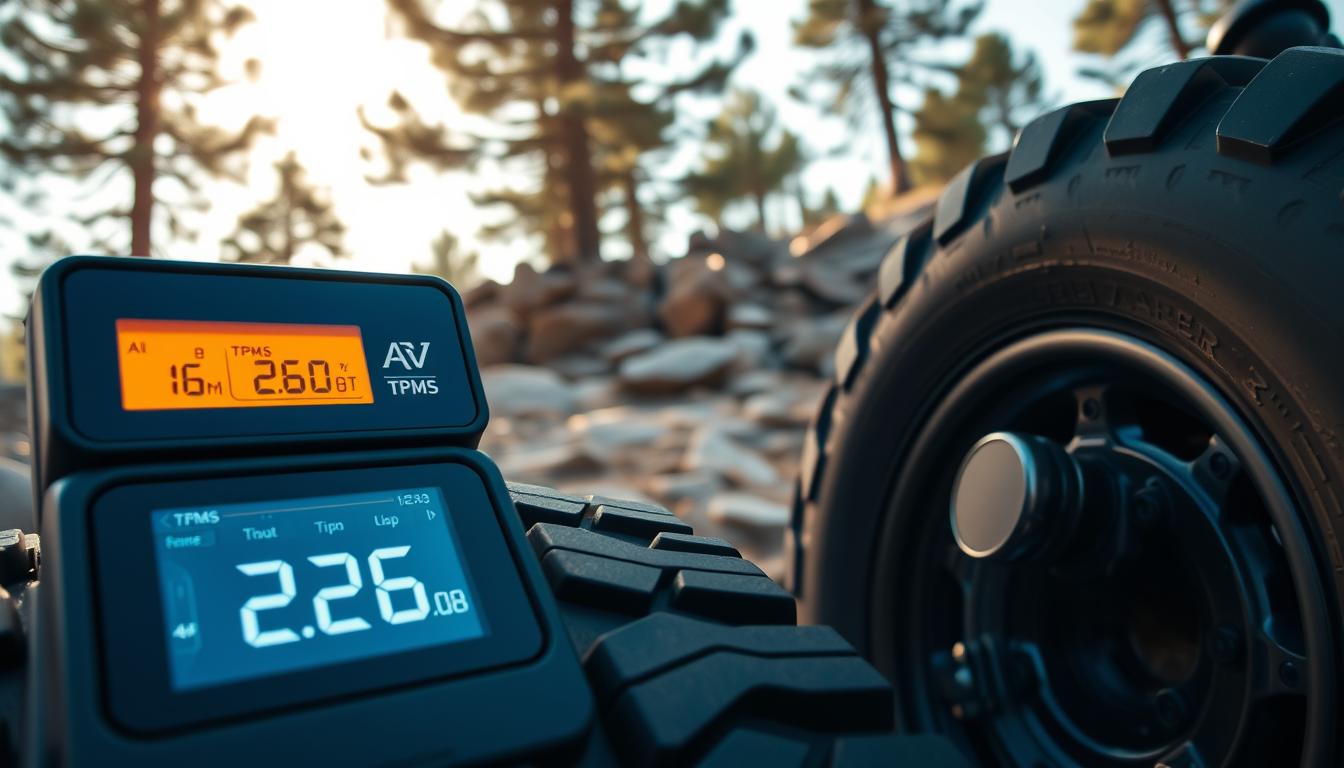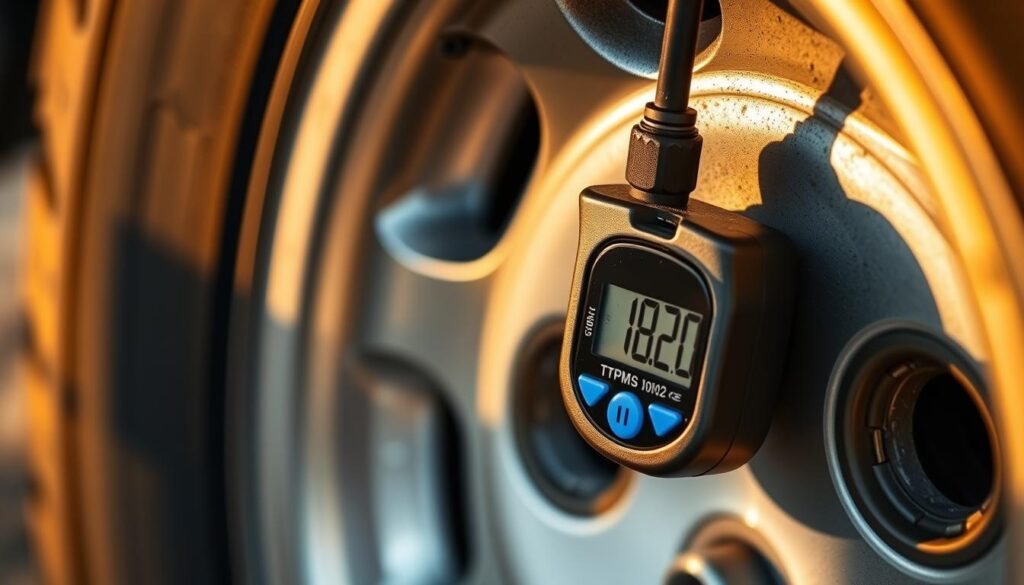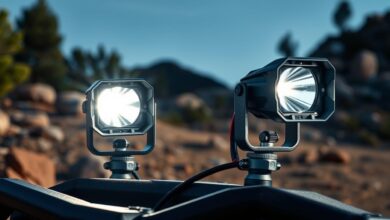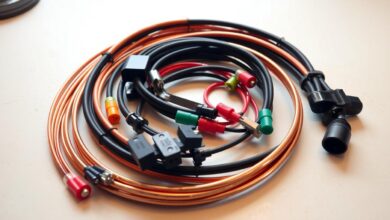Stay Safe Off-Road with the Best Tyre Pressure Monitoring Systems

Do you know the dangers of not checking your tyre pressure off-road? Keeping the right pressure is key for your safety and your vehicle’s performance. A tyre pressure monitoring system (TPMS) gives you live updates on tyre pressure and temperature. This helps prevent accidents and boosts your vehicle’s efficiency.
For off-road fans, a TPMS is a real game-changer. It lets you keep an eye on tyre pressure and temperature. This means you’re always driving safely and efficiently. With a TPMS, you can dodge expensive tire blowouts and lower accident risks. For example, the Tire Linc PRO system supports up to 20 tires and is great for off-road trips.
Key Takeaways
- Monitor tyre pressure and temperature in real-time with a TPMS.
- Improve off-road safety and reduce the risk of accidents.
- Avoid costly tire blowouts and damage.
- Enhance your vehicle’s performance and efficiency.
- Choose a TPMS that suits your off-road needs, such as the Tire Linc PRO system.
Understanding the Importance of Tyre Pressure Monitoring
Off-road driving needs precision, and the right tyre pressure is key. A Tyre Pressure Monitoring System (TPMS) helps keep the pressure right. It’s not just about saving fuel or making tyres last longer. It’s about staying safe and performing well.
What is a Tyre Pressure Monitoring System (TPMS)?
A TPMS is an electronic system that checks the air in your tyres. It tells you if the pressure is right in real-time. It has tire pressure sensors that watch each tyre’s pressure. If it’s too high or too low, it alerts you.
Why Off-Road Vehicles Need TPMS
Off-road vehicles face tough terrain and tyre damage. A TPMS is vital for these vehicles. It stops tyre blowouts, improves grip, and helps control the vehicle better. Keeping the tyres at the right pressure makes off-roading safer and more effective. For more info, check out this resource.
Risks of Low or High Tyre Pressure
Underinflated and overinflated tyres are both risky. Underinflation wears out tyres faster, uses more fuel, and increases the chance of blowouts. Overinflation makes tyres slippery, more prone to damage, and uncomfortable to ride in.
| Condition | Risks |
|---|---|
| Low Tyre Pressure | Increased tyre wear, reduced fuel efficiency, higher risk of blowouts |
| High Tyre Pressure | Reduced traction, increased risk of tyre damage, harsher ride |
Knowing the importance of tyre pressure monitoring and using a TPMS helps off-roaders avoid these risks. It makes driving safer and more controlled.
How Tyre Pressure Affects Off-Road Performance
When you go off-road, tyre pressure is key. It’s vital for your vehicle’s performance, safety, and efficiency.
Impact on Traction and Control
Tyre pressure affects your vehicle’s grip and control off-road. Under-inflated tyres can make it hard to move, on surfaces like sand or mud. On the other hand, over-inflated tyres can make the ride harsh and reduce stability. The right pressure ensures better grip and control.
Effects on Fuel Efficiency
Tyre pressure also affects fuel use. Under-inflated tyres make your engine work harder, using more fuel. But, the right pressure reduces this, saving fuel. This is great for off-road vehicles, saving money and time on long trips.
Consequences of Incorrect Pressure on Tyres
Wrong tyre pressure can harm your tyres. Under-inflation can cause heat buildup, leading to tyre damage and blowouts. Over-inflation makes tyres more prone to damage from debris. Both can shorten tyre life and make driving risky. A tire pressure monitoring device helps keep pressure right, making your tyres last longer and driving safer.
Types of Tyre Pressure Monitoring Systems
It’s important to know the different types of TPMS to pick the right one for your car. These systems vary to meet different needs and preferences.
Direct vs. Indirect TPMS
TPMS systems are split into direct and indirect types. Direct TPMS have sensors inside the tyres to measure pressure directly. This gives accurate, real-time data to the driver.
Indirect TPMS use the car’s ABS and traction control to guess tyre pressure. They’re cheaper but might not be as accurate as direct TPMS.
| Feature | Direct TPMS | Indirect TPMS |
|---|---|---|
| Accuracy | High | Medium |
| Cost | Higher | Lower |
| Installation Complexity | More Complex | Less Complex |
Wireless vs. Wired Systems
TPMS systems also differ in how they send data. Wireless TPMS use radio signals, making them easy to install and flexible.
Wired TPMS connect directly to the car’s electrical system. They’re reliable but can be limited by wiring.
“The choice between wireless and wired TPMS depends on your vehicle’s specifications and your personal preference for simplicity versus reliability.” – Off-Road Expert
Pros and Cons of Each Type
Each TPMS type has its advantages and disadvantages. Direct TPMS are accurate but cost more. Indirect TPMS are cheaper but less precise.
- Direct TPMS: High accuracy, real-time data, but higher cost and complexity.
- Indirect TPMS: Lower cost, simpler installation, but potentially lower accuracy.
- Wireless TPMS: Greater flexibility, easier installation.
- Wired TPMS: More reliable in some cases, but constrained by wiring.
When picking a TPMS, think about your car, driving habits, and budget.
Key Features to Look for in a TPMS
Choosing the right TPMS is key for a better off-road experience. It should give you accurate and timely tyre pressure info. This helps you make smart decisions about your tyre pressure.
Real-Time Data and Alerts
A good TPMS gives you real-time data on tyre pressure. This lets you keep an eye on your tyres all the time. You can then adjust them as needed. Also, a TPMS with alerts for tyre pressure issues can prevent damage or failure.
Real-time data and alerts boost your safety off-road. For example, if you’re driving in tough terrain, a sudden tyre pressure change might signal a problem. With alerts, you can fix issues quickly, lowering accident risks.
Compatibility with Off-Road Vehicles
Not all TPMS systems are the same. It’s important to find one that fits your off-road vehicle. Make sure it works well with your vehicle’s tyres and electronics. Check if it matches your vehicle’s make and model, and if it supports your tyre type.
When picking a TPMS, think about these compatibility factors:
- Tyre type (e.g., tubeless, tube-type)
- Vehicle make and model
- Electronic system compatibility
Durability and Weather Resistance
Off-road driving puts your TPMS through tough conditions like dust, water, and extreme temperatures. So, durability and weather resistance are key. A tough TPMS will last longer and work better in harsh conditions.
Look for a TPMS with a strong design and protective casing. This ensures it works well in tough environments. Some TPMS models are made to be waterproof or dust-resistant, perfect for off-road use.

| Feature | Description | Importance Level |
|---|---|---|
| Real-Time Data | Provides current tyre pressure information | High |
| Alerts | Warns of under or over-inflated tyres | High |
| Compatibility | Ensures integration with your vehicle | High |
| Durability | Withstands harsh off-road conditions | Medium |
| Weather Resistance | Protects against dust, water, and extreme temperatures | Medium |
Top Tyre Pressure Monitoring Systems for Off-Roading
For those who love off-roading, a good tyre pressure monitoring system is key. It’s all about precision and control. Keeping your tyres at the right pressure is vital for safety and performance.
Reviews of Market-Leading Models
There are many top TPMS models for off-roading fans. Here are some of the best:
- TPMS Model 1: It’s known for its accuracy and real-time data, making it a top choice.
- TPMS Model 2: It has advanced features like customizable alerts and works with many vehicles.
- TPMS Model 3: It’s durable and weather-resistant, perfect for tough off-road conditions.
For more reviews and comparisons, check out Giga-Tires. It’s a great resource for off-roading fans.
Comparison Chart of Key Features
| TPMS Model | Accuracy | Real-Time Data | Compatibility |
|---|---|---|---|
| TPMS Model 1 | High | Yes | Wide Range |
| TPMS Model 2 | High | Yes | Customizable |
| TPMS Model 3 | Medium | Yes | Specific Models |
Customer Ratings and Recommendations
What customers say is very important when picking a TPMS. Here’s what they think of the models mentioned:
- TPMS Model 1: 4.5/5 stars – Users love how easy it is to install and how accurate it is.
- TPMS Model 2: 4.7/5 stars – People like its advanced features and customer support.
- TPMS Model 3: 4.3/5 stars – It’s praised for its durability and how well it performs in harsh conditions.
When choosing a TPMS, think about accuracy, compatibility, and extra features. An ATV tire gauge is also a must-have for off-road fans.
Installation and Calibration of TPMS
To get the most out of your Tyre Pressure Monitoring System, proper installation and calibration are key. A well-installed TPMS ensures accurate tyre pressure readings. This is vital for safety and performance during off-road adventures.
DIY Installation Tips
Installing a TPMS can be a DIY-friendly task if you have the right guidance. Here are some tips to consider:
- Start by reading the manufacturer’s instructions carefully to understand the specific requirements of your TPMS model.
- Ensure that the sensors are correctly fitted to the tyre valve stems and that they are securely fastened.
- If your TPMS comes with a display unit, mount it in a visible location on your dashboard.
- Follow the manufacturer’s guidelines for pairing the sensors with the display unit.
It’s also important to check that the system is functioning correctly after installation. Drive your vehicle for a few minutes to ensure that the tyre pressure readings are displayed accurately on the screen.
Professional Installation Options
If you’re not comfortable with DIY installation or if your vehicle has complex requirements, consider opting for professional installation. Many auto repair shops and tyre specialists offer TPMS installation services. They have the necessary expertise and equipment to ensure that your TPMS is installed correctly.
Professional installation can also provide peace of mind, knowing that the job has been done correctly and that your warranty remains valid.
Calibration Process for Accuracy
Calibration is a critical step after installation. It ensures that your TPMS provides accurate readings. The calibration process typically involves:
- Setting the correct tyre pressure according to your vehicle’s specifications.
- Following the manufacturer’s instructions to calibrate the TPMS, which may involve driving at a certain speed for a specified period.
- Checking the TPMS display to ensure it’s showing the correct tyre pressure for all tyres.
Accurate calibration is essential for the TPMS to function correctly. Incorrect calibration can lead to misleading tyre pressure readings. This can compromise your safety on the road or off-road.
By following these guidelines for installation and calibration, you can ensure that your TPMS functions accurately. This will provide you with the data you need to enjoy safe and successful off-road adventures.
Maintaining Your Tyre Pressure Monitoring System
Keeping your Tyre Pressure Monitoring System (TPMS) in top shape is key for your vehicle’s safety and performance. A working TPMS boosts your vehicle’s performance and helps prevent tyre damage. It also ensures a safe drive.
Regular Checks and Maintenance Tips
Regular checks are vital for a well-functioning TPMS. Look for damage or corrosion on the sensors. Make sure they’re securely attached to the valves and valve caps are tight. Also, check the battery life of your TPMS sensors, as weak batteries can cause incorrect readings.
- Check the TPMS sensors for damage or corrosion.
- Ensure sensors are securely attached to the valves.
- Verify that valve caps are tightened properly.
- Monitor the battery life of your TPMS sensors.
For more detailed guidance on TPMS maintenance, check out Michelin’s TPMS guide. It offers detailed information on keeping your TPMS in good condition.
Troubleshooting Common Issues
Even with regular maintenance, TPMS problems can occur. Issues like inaccurate readings, sensor malfunctions, and false system alerts are common. Start troubleshooting by checking the sensor batteries and ensuring the sensors are clean.
- Check sensor batteries for weakness or depletion.
- Inspect sensors for dirt or debris that may interfere with their operation.
- Reset the TPMS system according to the manufacturer’s instructions.
- Consult the user manual or contact a professional if issues persist.
When to Replace Your TPMS
Knowing when to replace your TPMS is important for your vehicle’s safety and performance. If your TPMS sensors are over 5-7 years old, it’s time to replace them. Also, if you face frequent malfunctions or get inaccurate readings, it’s time for a new TPMS.
“Regular maintenance and timely replacement of your TPMS are critical for ensuring your vehicle’s safety and performance. By staying on top of these tasks, you can enjoy a safer and more enjoyable off-road driving experience.”
By following these maintenance tips and knowing when to replace your TPMS, you’ll keep your system working well. This ensures your safety and performance on off-road adventures.
The Role of Tyre Pressure in Off-Road Safety
Proper tyre pressure is key to off-road safety. It affects both how well your vehicle performs and how safe it is. The right pressure can mean the difference between a great adventure and a risky situation.
Importance of Proper Inflation
Keeping tyres at the right pressure is essential. It ensures you have good grip, control, and safety. If tyres are too low, they can slip, get damaged, and make your vehicle unstable.
On the other hand, tyres that are too high can be bumpy, lose grip, and get punctures easily. Proper inflation also saves fuel and makes your tyres last longer. Always check your tyre pressure before going off-road.

Tips for Adjusting Pressure for Different Terrain
Changing your tyre pressure for different terrains is important. For soft surfaces like sand or mud, lower the pressure. This helps your tyres grip better.
For harder surfaces like rocks or gravel, increase the pressure. This reduces the chance of punctures and keeps your vehicle stable.
- For sand and mud, reduce tyre pressure to increase the contact patch and improve traction.
- For rocky or gravel terrain, increase tyre pressure to reduce the risk of punctures and improve stability.
- For mixed terrain, find a balance that suits the majority of the conditions you’ll encounter.
Preparing for Off-Road Adventures
Before you go off-road, make sure your vehicle is ready. This includes checking and adjusting your tyre pressure. Here’s a quick checklist to get you ready:
| Check | Description | Status |
|---|---|---|
| Tyre Pressure | Check and adjust according to terrain | |
| Tyre Condition | Inspect for damage or wear | |
| Vehicle Maintenance | Ensure all vehicle systems are functioning properly |
By following these tips and keeping your tyres at the right pressure, you’ll greatly improve your off-road safety and driving experience.
Budgeting for a Quality TPMS
A reliable Tyre Pressure Monitoring System (TPMS) is key for off-roading. When planning your next adventure, think about the TPMS cost and how it fits into your budget.
Cost Considerations for Different Systems
The price of a TPMS changes based on its type, features, and vehicle compatibility. Direct TPMS, with sensors in each tyre, cost more than indirect systems that use ABS sensors.
When budgeting for a TPMS, consider these factors:
- The number of tyres the system can monitor
- The accuracy and reliability of the pressure readings
- Additional features such as temperature monitoring and alerts for low pressure
- Compatibility with your vehicle’s make and model
Budget-Friendly Options
For those on a tight budget, there are affordable TPMS options. These might lack some advanced features but offer reliable pressure monitoring.
| TPMS Model | Price (AUD) | Key Features |
|---|---|---|
| TPMS Basic | $150 | Pressure monitoring, low pressure alert |
| TPMS Advanced | $300 | Pressure and temperature monitoring, customizable alerts |
| TPMS Pro | $500 | Advanced pressure and temperature monitoring, real-time data, compatibility with multiple vehicles |
Investing in Safety and Performance
The initial cost of a TPMS might seem high, but it’s worth it. Proper tyre pressure improves fuel efficiency, tyre life, and safety on and off the road.
“Investing in a TPMS is not just about avoiding the cost of tyre damage; it’s about ensuring the safety of you and your passengers on every journey.”
By budgeting for a quality TPMS, you protect your vehicle and enjoy safer off-road adventures.
Conclusion: Choosing the Right TPMS for Safe Off-Roading
Off-roading requires keeping an eye on your tyre pressure. A good Tyre Pressure Monitoring System (TPMS) is key. It helps keep your tyres at the right pressure, improving your vehicle’s performance and lowering tyre damage risks.
Prioritizing Tyre Safety
Tyre safety is essential for off-road trips. Tyres that are not the right pressure can cause problems. They might not grip the ground well, increase the chance of tyre failure, and make it harder to control your vehicle.
By choosing a suitable TPMS, you can always know your tyre pressure. This lets you adjust it quickly to keep it at the best level.
Investing in Safety Technology
When researching and purchasing a TPMS, look at things like how well it fits your vehicle and how long it lasts. A good TPMS is a smart safety choice for the trails. By doing your research and picking the right one, you can stay safe off-road and have fun without worry.
With the right TPMS, your off-roading trips will be better. Your vehicle will be ready for different terrains, keeping your tyres safe and your journey smooth.
FAQ
What is the primary function of a Tyre Pressure Monitoring System (TPMS)?
A TPMS checks your tyre air pressure and warns you of any changes. It keeps you safe on and off the road.
How does a TPMS improve off-road safety?
A TPMS keeps your tyres at the right pressure. This boosts traction and control. It also lowers the chance of tyre blowouts, preventing accidents.
What are the consequences of driving with incorrect tyre pressure?
Wrong tyre pressure can cause less grip, tyre damage, and lower fuel efficiency. It also harms your vehicle’s performance, posing a big safety risk.
What is the difference between direct and indirect TPMS?
Direct TPMS uses sensors in the tyres to measure pressure directly. Indirect TPMS guesses pressure from wheel speed and vehicle data. Direct systems are usually more accurate.
How do I choose the right TPMS for my off-road vehicle?
Look at compatibility with your vehicle, the terrain you’ll drive on, durability, and if it gives real-time data and alerts. These factors help choose the right TPMS.
Can I install a TPMS myself, or do I need professional help?
Some TPMS models are easy to install yourself. Others might need a pro. Always follow the manufacturer’s instructions.
How often should I check and maintain my TPMS?
Regular checks are key. Check your TPMS often, fix any problems quickly, and replace it if needed. This keeps you safe and your system working well.
Are there budget-friendly TPMS options available?
Yes, there are affordable TPMS options. But, make sure to balance cost with quality and features. Choose a reliable system that meets your needs.
How does tyre pressure affect fuel efficiency during off-roading?
Right tyre pressure cuts down rolling resistance, boosting fuel efficiency. Underinflated tyres increase fuel use. So, a TPMS is a great tool for off-roaders.
What are the benefits of investing in a quality TPMS?
A good TPMS boosts your safety and your vehicle’s performance. It also lowers the risk of tyre problems. It’s a smart investment for serious off-roaders.





